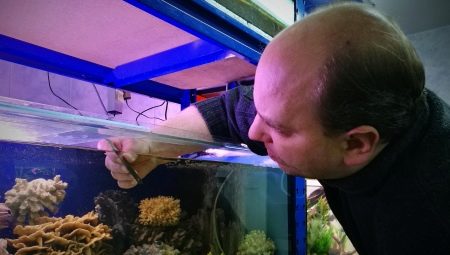The aquarium is an interior decoration, at the same time moisturizes the air in the room and contributes to the emotional discharge of the owner after a busy day.
Many cafes and shopping centers use beautiful aquatic systems to attract visitors, because you can watch the fish for hours. Sometimes aquariums are located in the offices of chiefs and directors, because observing the fish, as well as caring for the aquarium perfectly reduces stress and improves mood.
Partial replacement of water not only helps maintain aesthetics and beauty, but also has a beneficial effect on the health of aquarium inhabitants.
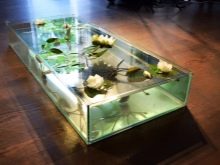
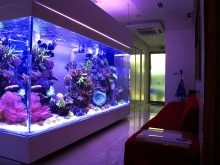
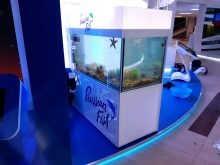
What is it for?
The aquarium is a closed ecosystem with its own bio-balance, turbidity or other water pollution indicates a disturbance in the fragile balance. Turbid or sour water adversely affects the fish, slows the growth of plants and can lead to diseases and even death of the entire ecosystem in the aquarium.
Important is regular fluid changes, it helps maintain a normal nitrogen cycle. Keeping the aquarium water clean helps a special filter and aerator, however, regular partial replacement, additional cleaning of the bottom of the aquarium and removing plaque from the walls are very important conditions for maintaining clean water.
A complete fluid change should only be carried out if absolutely necessary. as it is a stress for the inhabitants, and the microclimate after such a restart is built anew.
In dirty water, fish breed poorly, begin to hurt and die.Especially harmful water affects expensive species of fish, as they are bred artificially and have fragile health.

What affects the frequency of replacement?
Changing the water in the aquarium is not necessary so often and it is not difficult to do it.
The opinions of aquarists differ only in one thing: change the water completely or leave ¼ of the “old” liquid (having previously cleaned it) for the best and faster restoration of the microclimate after the general cleaning. If the plants or fish become ill, it is necessary to quarantine them in an empty container without decor, rinse everything thoroughly and completely change the water.
Proper water changes will help to avoid general cleaning as long as possible.

If the capacity is from 60 liters to 100 liters, it is recommended to replace the liquid according to the schedule:
- 1 time in 2-3 weeks to clean the bottom and add water to the usual level;
- once a month and a half to clean the walls, the bottom, rinse the filter filler, clean the decorative elements with a brush (if they have a touch of brown / green microalgae) and renew 1/4 of the liquid in the aquarium;
- about once a year (it’s possible and less often) to carry out a full general cleaning: place the fish in a separate container with clean water, thoroughly wash the entire aquarium, plants and decorative elements (in this case, ¼ of the “old” aquarium liquid must be passed through gauze folded in 3 layer and add to a clean aquarium).
A small aquasystem is too troublesome, despite the ubiquitous PR of 10-liter tanks, they are hopeless, suitable for keeping 1-2 fish (or growing fry) with the condition of weekly cleaning of the bottom and glass, as well as replacing a quarter of the water. The fluid in such aquariums constantly acidifies, blooms and becomes cloudy.
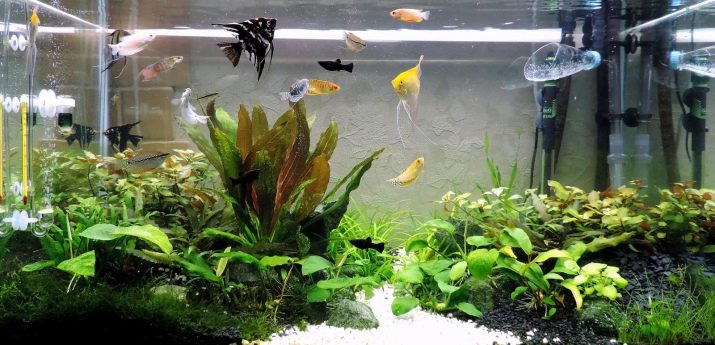
A large aquarium (from 300 liters and more) needs to be replaced much less frequently, the main thing is to populate it correctly and arrange it at the first start. If the water is quickly and intensively polluted, it is necessary to find the cause and eliminate it. Among the possible causes of rapid turbidity or flowering of water, the following can be distinguished:
- too small aquarium capacity (10 liters);
- the aquasystem is installed near the window on the sunny side of the house and the water blooms profusely;
- overpopulation of the aquarium (1 liter of liquid is needed for 1 fish 3 cm in size, 8-10 liters are needed for a 10 cm fish);
- there is no filter in the aquarium or it is defective;
- increased temperature conditions provokes acidification of the liquid;
- the presence of snails, especially large species (despite the generally accepted opinion that snails clean walls, the amount of their excrement is twice the benefit of cleaning glasses);
- use of low-quality soil;
- a thick layer of duckweed on the surface of the water creates the effect of bogging;
- overfeeding of fish and sedimentation of part of dry or live food to the bottom;
- feeding fish with breadcrumbs or raw minced meat;
- poor quality of the water itself (for example, with a high content of iron or lime);
- the use of low-quality weights for plants;
- the use of ordinary river sand as a coating at the bottom (it is impossible to clean it, fish often dig such a bottom and raise sand).
Ideally, with proper care and maintenance of the aquarium, the water should remain clear and odorless for several years.
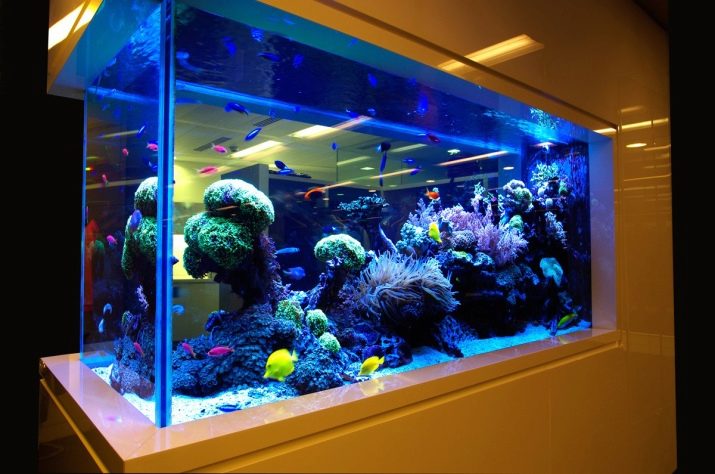
Optimal timing
Before the first launch, all the walls in the new aquarium must be washed with baking soda and rinsed thoroughly. After installation in the right place, pour the settled tap water, fill with decorative elements and let stand for 2-3 days. If the water remains clean and transparent, you can run fish.
The number of inhabitants, plants and feed must be carefully calculated and always keep these data handy until they become a habit. Even the most unpretentious fish should not overpopulate the aquarium.Extra animals can be sold or given away, as well as plants, because some grow very quickly.
Excess feed adversely affects the digestive system of fish and contributes to a very rapid turbidity of the water.
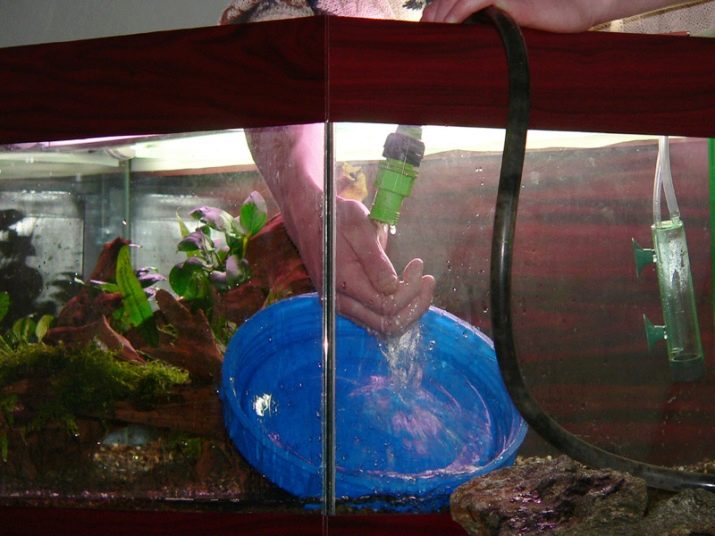
It is necessary to change the liquid almost completely no more than 1 time per year in aquariums from 30 to 50 liters, the rest of the time, only partial replacement of the water that decreases during the cleaning process and due to natural evaporation should be done. Frequent fluid replacement disrupts the microclimate in the aquarium and adversely affects its inhabitants.
In tanks with a capacity of 20 l, it is more difficult to maintain cleanliness and biological balance than in large ones, but fluid replacement is recommended no more than 1 time per week. It is better for novice aquarists to buy a container of at least 40 liters in volume to facilitate ecosystem care.
After the first start, it is advisable not to add water for two months to establish biological equilibrium, but you need to clean the bottom and walls regularly.
The first change in the new aquarium should be no more than 10 percent of the total tank volume.
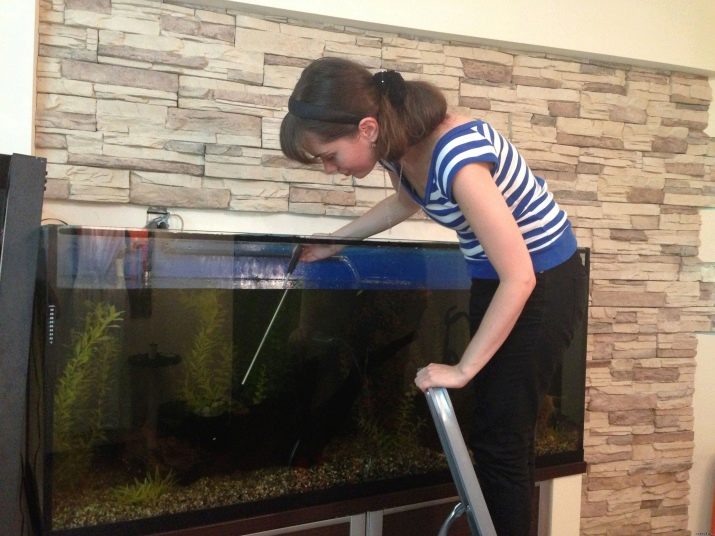
In large aquariums with a capacity of more than 100-200 l, the task of keeping the ecosystem clean is greatly simplified. A container of this volume will be contaminated much longer; bottom cleaning can be done once every 3 weeks. Water should be added as necessary (first you need to let it stand for several days). If a precipitate forms in the settled liquid, it must not be poured out completely so that the settled particles do not get into the fish.

Required Inventory
Before changing the water, it should be allowed to stand in a clean glass jar covered with gauze (fixed with a regular elastic around the neck) for 5-7 days. It is impossible to boil water for fish, since the boiling process kills oxygen and beneficial bacteria (such water is useless and is considered inanimate).
In order to facilitate the process of changing or changing fluid in the aquarium, it is recommended to use the following tools:
- glass scraper or piece of gauze;
- net for fish;
- scissors for thinning out excess plants (take out the roots from the soil very carefully so as not to damage the plant and not to raise dirt from the bottom);
- container for extra fish and plants (it is advisable to use a clean glass jar);
- a siphon with a pear or an ordinary tube plus a hose for cleaning the soil;
- bucket for drained dirty liquid.
A hose of at least 1.5 m in length is recommended. A filter filler may also be needed if it is planned to be cleaned.

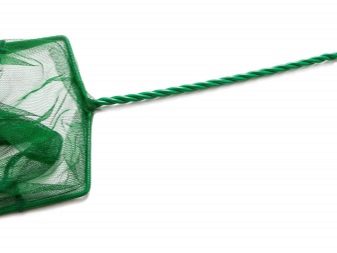
In the process of changing the water, you can catch the existing fry with a net with a small net, if you plan to grow them (before that, you need to read when to plant young stock, in different species of fish, these periods differ).
If there are a lot of plants in the aquarium, you can use special diffuser spraying carbon dioxide. Thinning plants is convenient with tweezers, but it is not necessary to use it.
In the process of breeding expensive breeds of fish, you can use special tests for water, which help to accurately determine the composition of the liquid and make sure the need for a fluid change.
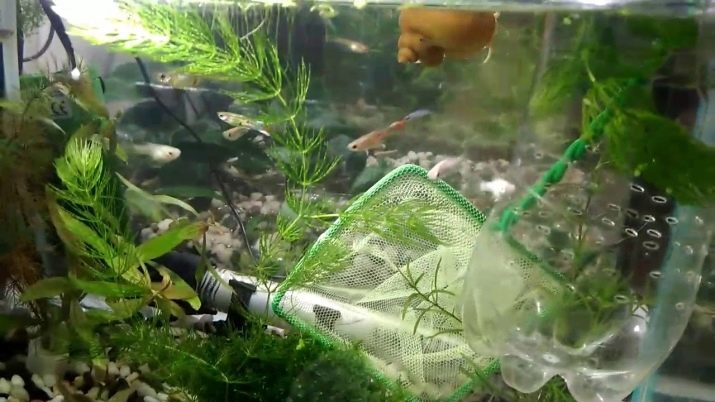
Rules of procedure
The age of the aquarium affects the frequency of fluid changes. The first aquarium is considered the first 2 months after launch, and it is not recommended to touch the water in it. It is considered young from 2 to 3 months, and a fluid change should be no more than 1/5 of the total volume, not more than 1 time in 2 weeks. Mature aquarium - from 3 to 6 months, water change - once a week. The aquarium becomes old by the age of two and requires replacing the minimum amount of water that decreases during the cleaning process (no more than 1/6 of the total volume).
Partial water changes are recommended according to the following algorithm (you do not need to plant fish, just be careful):
- clean the walls of the aquarium with a special scraper or a piece of gauze from green / brown deposits;
- remove loose leaves of plants, excessive duckweed;
- put in a separate container extra fish, snails and plants to sell or give them (or exchange them for food and other necessary things);
- clean the bottom of the waste products of the inhabitants of the aquarium and the rest of the feed using a special tube with a hose;
- wash your hands thoroughly (you can use an odorless, transparent detergent to wash children's dishes);
- remove plaque from the edge of the water from the glass with a piece of gauze;
- if the water is cloudy, drain a quarter of the tank volume through the hose;
- add settled clean water to normal level.
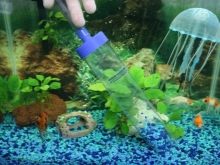
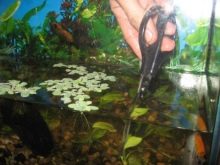
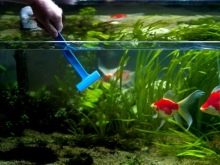
A complete water change is rare, takes longer than a partial change. Rules for a complete water change (such a change must be combined with general cleaning of the aquarium, simply draining / adding water will not have any effect and after a couple of days the water will cloud again):
- fish and snails must be deposited in a separate container with clean water;
- plants should be put in a basin with water, washed thoroughly, remove the clutch of snails (if they are not needed) and the plaque of microalgae (very carefully, using gauze);
- all decorative elements should be thoroughly washed with a hard new toothbrush (you can use baking soda, but then rinse thoroughly under running water);
- all water should be scooped out or drained through a hose;
- the aquarium must be washed with soda and rinsed very carefully;
- the soil should be washed under high pressure of water from the shower;
- fill the tank a third with clean water;
- equip the bottom, distribute the decor, fix the aerator, filter, heater;
- to plant plants and carefully mask their roots;
- put a clean deep plate on the bottom and slowly add water to a normal level with a thin stream;
- in an hour you can run all the inhabitants back into the aquarium.
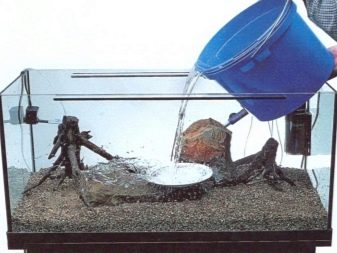

Changing water completely in an aquarium of any capacity is not difficult, but you need to do this only in case of emergency. Correct and regular replacement of aquarium water ensures the maintenance of a healthy microclimate, has a beneficial effect on the health of its inhabitants and gives aesthetic pleasure to its owner.
How to change the water in the aquarium is shown in the next video.
